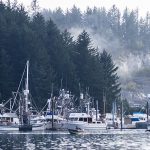Ocean changes can have dramatic implications for coastal communities and economies. How far north are fishermen willing to follow shifting fish populations? Are fishing trips longer during warmer years, causing fishermen to spend less time in port communities? Fishery managers, communities and industry players need answers to these questions and others so they can prepare for the environmental changes happening in our state.
Researchers Franz Mueter and Jordan Watson used data from 30,000 fishing vessel trips over seven years, considering items including ship locations, fishing landings and observer data to figure out how fishing trips varied. They found that larger pollock vessels may be more resilient to shifting pollock distributions because they can travel farther to follow the fish. However, during low abundance years large vessels were not immune to the lower catches per day experienced by smaller vessels.
This is the first study to use the satellite-signal vessel monitoring system, mandated on pollock vessels, to identify specific fisheries by gear, region, and target species in US fisheries. Their innovative approach has now been adapted for vessels in the Gulf of Mexico in various gear groups, indicating its broad utility.






